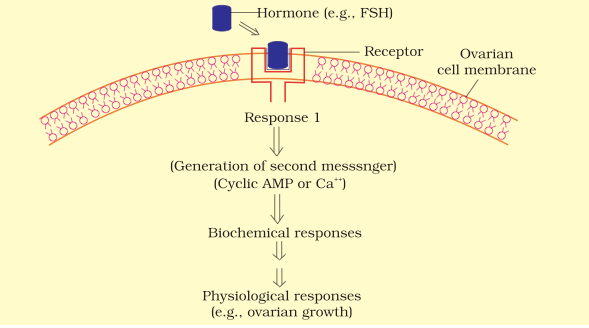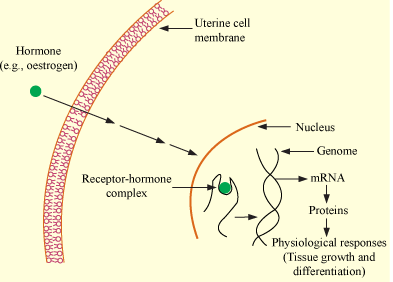 |
Hormones act as chemical messengers in the body, secreted by endocrine glands and carried through the bloodstream. They have specific targets and bind to receptors. Based on the mechanism of hormonal action, it can be categorized into two groups: fixed membrane receptor mechanism and mobile receptor mechanism.
1. Fixed membrane receptor mechanism:
- Hormones such as Growth hormone, ADH, oxytocin, Insulin, Adrenaline, FSH, TSH, etc., follow this mechanism.
- These hormones are water-soluble and cannot pass through the lipid membrane. They bind to specific receptors on the cell membrane.
- Binding of the hormone to its specific receptor on the target cell activates the enzyme Adenylcyclase in the cell membrane, leading to the production of cyclic AMP (cAMP).
- cAMP acts as a secondary messenger, diffusing through the cell membrane and activating various enzymatic reactions, usually involving Protein Kinase, to bring about biochemical changes.
- Once the target cell responds to the changes, cAMP is deactivated by an enzyme called Phosphodiesterase.
 |
| Figure: Fixed membrane receptor mechanism of hormone action( Eg. FSH) |
2. Mobile receptor mechanism:
- Lipid-soluble hormones such as steroid hormones (testosterone, progesterone, estrogen, cortisol) and fatty acid hormones can easily pass through the plasma membrane.
- These hormones have receptors located inside the cell, freely floating in the cytoplasm.
- Binding of the hormone to its specific receptor activates enzymatic activity within the cell, leading to biochemical changes.
- Some hormones, like testosterone, progesterone, estrogen, cortisol, and thyroxine, have their receptors localized inside the nucleus. The hormone-receptor complex is transported into the nucleus.
- Once inside the nucleus, the hormone-receptor complex initiates transcription of DNA, resulting in the formation of specific mRNA.
- The mRNA then initiates protein synthesis in the cytoplasm, and the synthesized proteins (enzymes) cause biochemical changes in the cell.
 |
| Figure: Mobile receptor mechanism of hormone action (Oestrogen) |
Hormones also act as regulators in maintaining the body's internal environment. The secretion of hormones can be regulated through feedback control, which can be positive or negative:
1. Positive Feedback Control: In this process, the end products of an action stimulate more of that action to occur in a feedback loop. Examples include blood clotting and the menstrual cycle.
2. Negative Feedback Control: In this type of regulation, the end product of a process reduces the stimulus of that same process. Examples include temperature regulation and the regulation of blood sugar.
Hormones can also function as messengers. The neurosecretory cells of the hypothalamus secrete hormones called neurohormones into the blood. These neurohormones are carried to the pituitary gland, stimulating it to release various hormones. They are often referred to as "releasing factors" due to their role in stimulating hormone release.











0 Comments